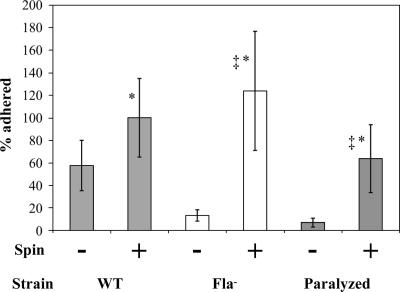FIG. 5.
Centrifugation restored surface attachment of nonmotile mutants. Initial surface attachment of the flagellum-minus (Fla−) and paralyzed-flagellum (Paralyzed) mutants was restored to wild-type levels by exogenously supplying surface-directed motion via centrifugation (∼1,900 × g) for 1 h. Also shown are the data for the adherence of the different strains when left in standing culture for 1 h. When the level of adherence by the spun wild-type strain is compared to that of either the spun flagellum-minus mutant or the spun paralyzed-flagellum mutant, it is not significantly different at the 95% confidence interval as determined by one-way ANOVA followed by Tukey's multiple comparison test (set at 5%), as denoted by the asterisk. In contrast, when the adherence of the spun flagella-minus mutant and the spun paralyzed-flagella mutant are compared using the same statistical analysis, the level of adherence is statistically different at the 95% confidence interval, as denoted by the double dagger. Cells/hpf were counted after glass coverslips were washed. The number of cells attached per hpf to glass coverslips was normalized such that the average number of cells/hpf for the wild type for each experiment was set at 100%. Data are from four independent experiments, each using one coverslip per strain and condition, and 5 hpf were analyzed per coverslip. Error bars represent standard errors of the means.

